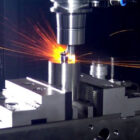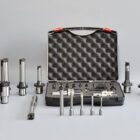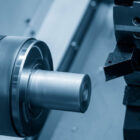The pursuit of ideal speeds and feeds is essential in the field of machining to guarantee accuracy and efficiency, where boring bars introduce an additional layer of intricacy. A sophisticated strategy is necessary to navigate the complexities of boring operations, which includes expertise and skill, right from determining the proper tool geometry to synchronizing with machine capabilities and understanding material hardness. The blog below explores the nuances of cutting parameter optimization for boring bars, giving machinists a road map to improve productivity, prolong tool life, and confidently handle the complexities of internal machining. Let’s uncover the secret to achieving optimal outcomes in boring operations, where efficiency and precision collide, by learning how to optimize feed and speed.
Material hardness
Material hardness has a significant impact on how well boring bar speeds and feeds are optimized during machining processes. A material’s inherent properties have a significant influence on how the cutting tool interacts with it, which is why careful consideration is important for efficient machining.
- When machining soft materials, which have a lower hardness, faster speeds are frequently needed. By keeping the tool from becoming lodged in the material and lowering the possibility of built-up edge creation, the faster cutting action helps maintain an effective cutting action. This is especially important when trying to get smoother finishes on softer workpieces.
- On the other hand, slower speeds are required for harder materials in order to prevent excessive tool wear and heat buildup. Lower speeds prolong tool life by reducing heat and friction. Additionally, while cutting through harder materials, slower speeds can avoid chipping or breaking the cutting tool due to the greater resistance.
Machinists must balance generating high-quality surface finishes, increasing tool life, and reaching the required material removal rates, while negotiating the challenges of material hardness. Across a range of materials with different degrees of hardness, optimizing speeds and feeds is crucial to obtaining accuracy and productivity in boring bar operations.
Tool geometry
The ideal speeds and feeds for machining processes are determined in large part by the geometry of a boring bar. This feature includes a number of design components that can have a direct impact on the tool’s efficiency and cutting performance. Because different tool geometries are designed for different tasks, machinists must choose their tools carefully.
- One important piece of geometry that affects the direction and effectiveness of chip evacuation is the rake angle. For stronger materials, a negative rake angle may increase tool strength, whereas a positive rake angle encourages smoother cutting.
- Another geometric factor to take into account is the clearance angle, which influences the tool’s capacity to fit into confined places and avoid interference with the machined surface. Selecting the right clearance angle is crucial to accomplishing accuracy while performing internal machining operations.
A boring bar’s size, shape, and other design elements all have an immediate effect on the creation of chips, the release of heat, and the cutting forces. Optimal geometry, which includes variables like rake and clearance angles, guarantees effective feeds and speeds, which lowers tool wear and improves surface quality in a variety of machining applications.
Machine capabilities and rigidity
The optimization of speeds and feeds for boring bars is highly dependent on the capabilities of the machining equipment, namely spindle speed and rigidity. Achieving a harmonic balance that stops tool deflection and vibration and ensures accuracy in machining processes requires matching these capabilities with the cutting settings.
- One important factor to take into account is the spindle speed, which is the boring bar’s rotating speed, which has a direct impact on the rates of material removal and cutting action. A proper spindle speed choice that is in line with the demands of the machining process is essential to minimize tool chatter and maximize productivity.
- Machine rigidity is equally crucial because it immediately affects the stability of the whole machining process,. A rigid machine construction reduces vibrations and improves boring bar accuracy. It is thus wise to maximize machine rigidity to achieve optimal speeds and feeds.
Striking a balance between spindle speed and machine rigidity is crucial. While an overly stiff setup with a low spindle speed might result in decreased material removal rates, an excessively high spindle speed without enough rigidity can cause tool deflection and poor surface smoothness. Achieving the ideal balance is crucial to maximizing the machining equipment’s potential and improving boring bar performance across a range of machining applications.
Cutting parameters
Optimizing boring bar performance requires a precise balance of cutting parameters, which involves adjusting feeds and speeds to get the best possible balance between surface finish, material removal rates, and tool life. A sophisticated comprehension of the interactions between diverse elements is necessary for the optimization process. To avoid sacrificing productivity while reducing tool wear, machinists must strike a careful balance. Finding the sweet spot where the boring bar works best to provide lifespan and accuracy in machining processes is the most challenging aspect.
- Cutting speed charts are one method for reaching this balance, allowing machinists to choose the right parameters depending on material and tool concerns.
- Another useful strategy is experimentation, which enables modifications to be made repeatedly until the ideal equilibrium is attained. Real-time feedback is provided through continuous tool performance monitoring during the machining process, which helps to detect and address any deviations from the intended parameters.
By using these techniques, the challenges of internal machining and optimising boring bar performance can be negotiated. This careful balancing guarantees that boring bars fulfil the accuracy and efficiency requirements of various machining applications, resulting in outstanding results.
Now that you’re capable of negotiating the challenges of internal machining, resulting in previously unheard-of levels of performance from boring bars, you can now confidently work with these tools. Yet, it is always advised to get only the best quality boring bars for any application. FineTech Toolings is a prominent choice for anyone looking for precision boring bars manufacturers in Bangalore. FineTech Toolings, a company well-known for their precise engineering, offers superior boring bars, guaranteeing that machinists have dependable instruments that are in perfect harmony.






